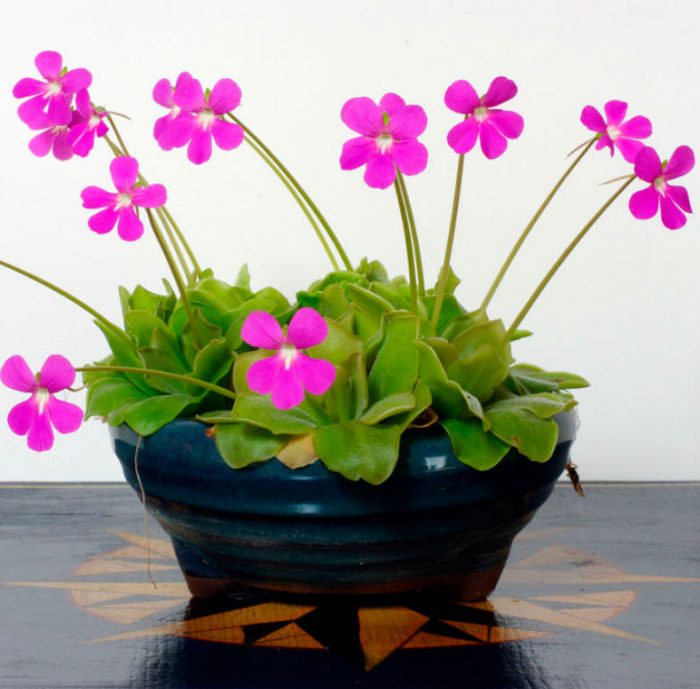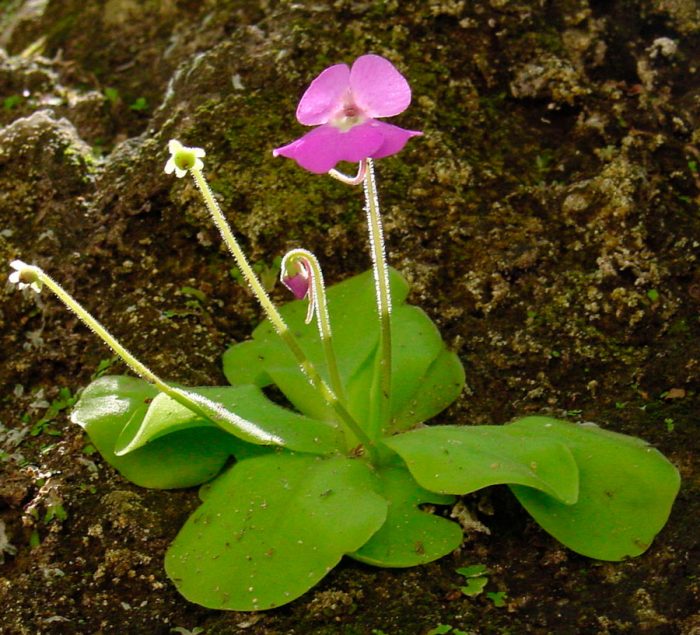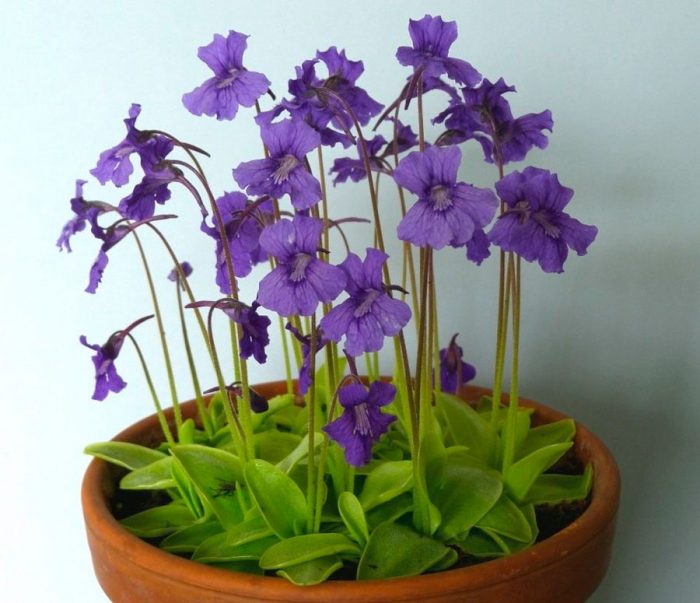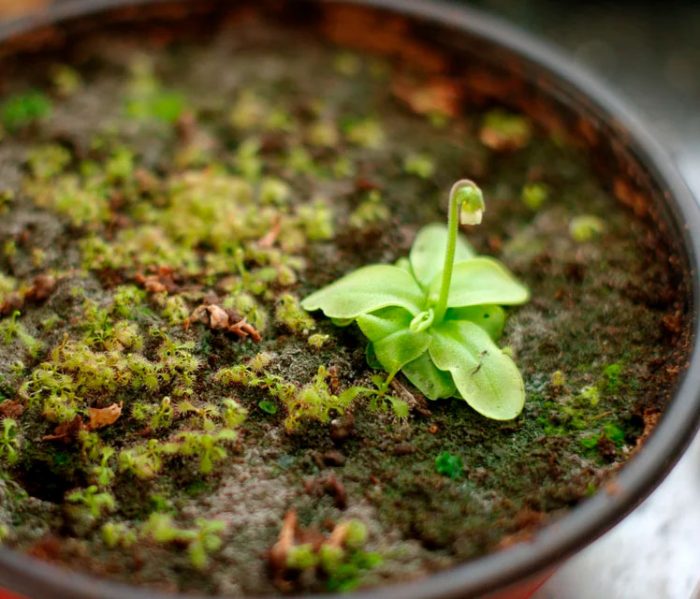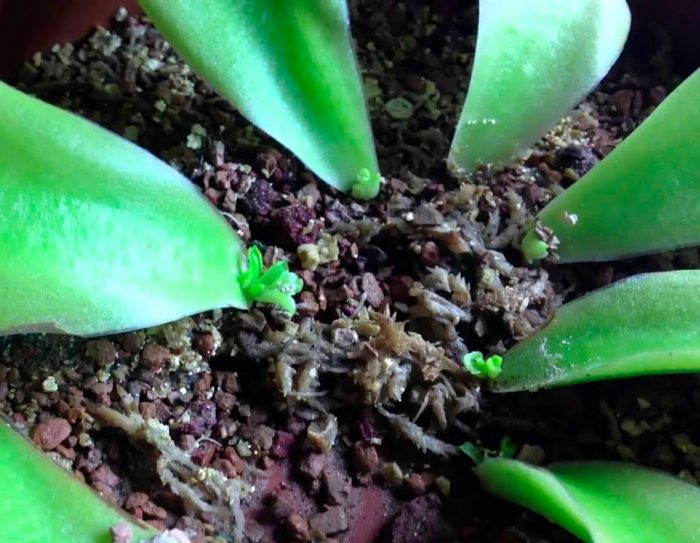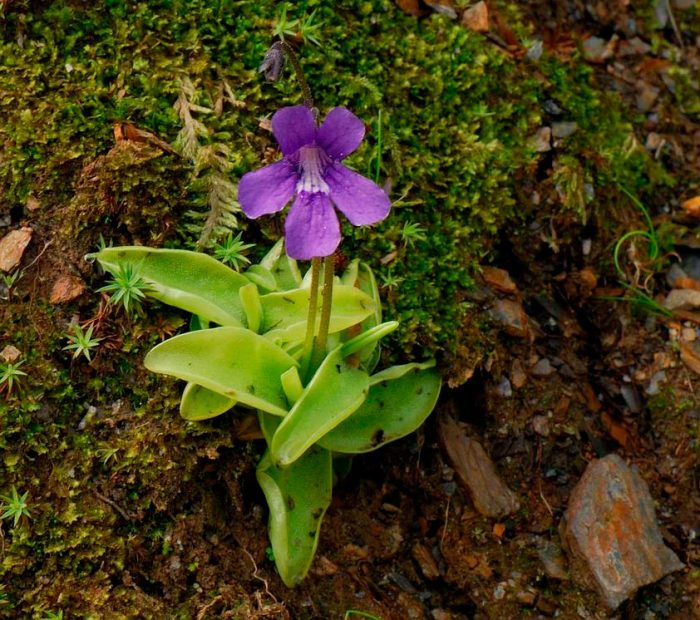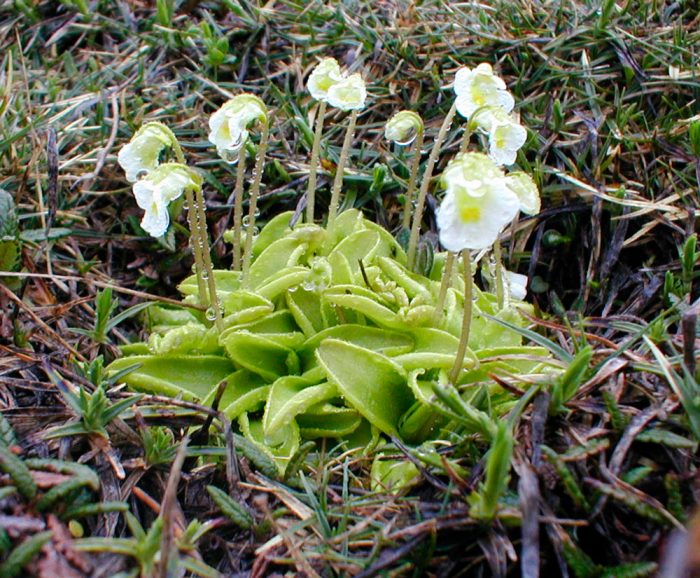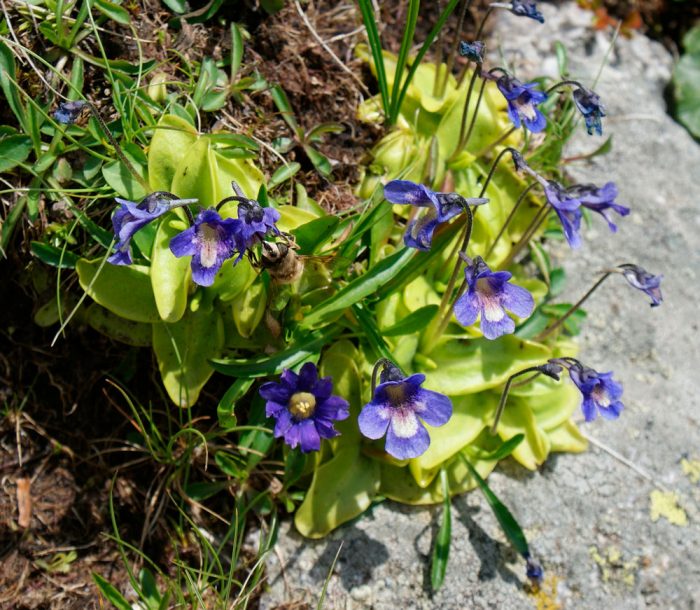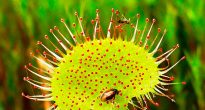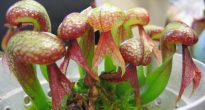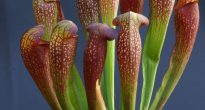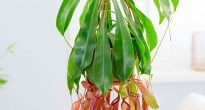Chiryanka (Pinguicula) is a herbaceous compact perennial, which is part of the perennial family. Basically, this plant is found naturally in marshy areas in the temperate regions of the Northern Hemisphere. Some of the varieties are found in the subtropics of America, as well as in the Arctic regions. This plant comes from Europe, there are about 12 of its species.
Zhiryanka is one of the carnivorous plants. Its main food source is various insects. To lure and absorb insects, the plant has fleshy leaf plates, on the surface of which there are a large number of sticky thin hairs. Leaf plates are part of dense rosettes, which can be up to 15 centimeters high. In spring, tall peduncles grow from the middle of the leaf rosette, which reach a length of about 0.4 m. Single small purple flowers open at their tops. Under natural conditions, you can meet varieties of birch with flowers of yellow, white, pink and blue hues.
Zhiryanka does not grow very quickly, while its flowering is observed in spring. Among all predatory plants, the fatty plant is the most unpretentious and undemanding to care for. She is a perennial plant.
Content
Brief description of cultivation
- Temperature... In the summer - from 25 to 35 degrees, and in the winter - from 15 to 18 degrees.
- Air humidity... Should be increased, however, the foliage from the sprayer should not be moistened and washed. It is recommended to grow the shrub in a terrarium where high humidity is required.
- Illumination... Moderate, while the rays of the sun should be diffused. In the room, this flower feels normal both under artificial lighting and in a shaded place.
- Watering... In summer, it is moderate - once every 2 or 3 days, and in winter, not so often - once every 7 days.
- Soil mixture... Must be acidic and well-drained. For example, you can take a mixture of sand and peat, while sphagnum or vermiculite is added to it for greater looseness.
- Fertilizer... Do not feed.
- Transfer... Young bushes - every year, and adults - once every couple of years.
- Reproduction... By leaf cuttings, by seed method and by dividing rosettes.
- Possible problems... The bush reacts negatively to an overly tight container, it can hurt a lot because of this and not bloom. It is not recommended to disturb the plant by turning it with the pot relative to the light source.
Caring for zhiryanka at home
Bloom
As a rule, indoor zhiryanka begins to bloom in the spring. From the middle of the leaf rosettes, tall peduncles grow in her, on the tops of which single small flowers appear, which outwardly resemble violets. They are usually purple in color, but varieties with white, blue, pink or yellow petals can be found.
Temperature
During the growing season, the flower feels best at an air temperature of 25 to 30 degrees, and in winter - from 15 to 18 degrees. Grease can grow at a temperature of about 35 degrees, but in this case it must be watered regularly, and also maintain a high level of humidity.
Spraying
Wipe with a sponge, moisten from a spray bottle and even just wash the foliage, otherwise the above-ground part of the bush may be damaged and rot will appear on it. To maintain high humidity, it is recommended to put the plant pot on a wide pallet, which is filled with moist expanded clay. However, it feels best in the terrarium.
Illumination
The plant does not need excessively bright light, while it needs to be protected from direct sunlight. Place the bush on a western or eastern windowsill. If desired, it can be placed in the back of the room, because it grows well under artificial lighting.
Watering
During the growing season, the plant is provided with regular moderate watering (2 or 3 times a week). In winter, the pudding is watered less often (about 1 time in 7 days). The water should be well-settled and not cold. Make sure that droplets of liquid do not fall on the foliage, as this can cause rotting of the bush and its further death. If desired, watering can be carried out through the tray, while making sure that the substrate in the pot is slightly damp all the time.
Choice of capacity
In a too cramped pot, the flower will not be able to grow and develop normally, as well as bloom. Therefore, they take a spacious pot. The root system of the plant is weak, and in order to prevent its decay, it is necessary to completely eliminate the stagnation of liquid in the substrate. Remember that there must be drainage holes at the bottom of the container.
Substrate
A soil mixture for planting and transplanting is chosen well-drained and it is better if it is acidic. In order to make it yourself, combine sand, peat and vermiculite (or sphagnum).
Top dressing
It is not necessary to additionally feed the zhiryanka. An excessively large amount of nutrients in the soil mixture can have an extremely negative effect on the development of the plant, up to its death. Feeding the bush with insects on your own is also not worth it, because the flower will cope with this on its own. However, you can attract flies to the plant by placing a sliced fruit next to it.
Zhyryanka transplant
During the first years of life, young bushes need a regular annual transplant, which is carried out at the beginning of spring. Carefully transfer the bush together with the clod of earth into a new container. If you wish, you can remove part of the old soil mixture, but in no case injure the weak roots, as this may cause the fatty to die.
Adult bushes are transplanted once every 2 years or even less often. The transplant is carried out only after the root system becomes cramped in the pot.
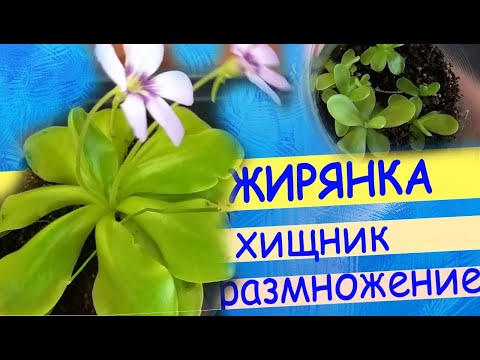

Watch this video on YouTube
Pruning
You do not need to cut off the room fat. However, it is recommended to promptly remove injured or withered peduncles and leaf plates. In this case, the bush can maintain its decorative effect for a long time.
Dormant period
The dormant period occurs in autumn and winter. At this time, watering is reduced, and also make sure that the room is moderately cool (from 15 to 18 degrees).
Reproduction methods
Growing from seeds
Indoor fat can be grown from seeds. However, it is quite difficult to do this and it is not a fact that your attempt will be successful. Sowing seeds is carried out in a light soil mixture that allows water to pass through well. It is not necessary to sprinkle them on top or to bury them in the substrate. From above, the crops are covered with glass or film.
The air temperature should be from 22 to 24 degrees, the light should be bright and diffused, and the humidity should be high. Only in this case the first seedlings can appear several weeks after sowing.
After emergence, make sure that they do not rot. To do this, provide the plants with systematic ventilation and moderate watering, and also protect them from sudden changes in temperature. When the plants are 15–20 days old, they can be planted in individual containers.
Propagation by leaf cuttings
Autumn is best suited for propagation by leafy cuttings. Carefully cut off the leaf plate, sprinkle the cut with charcoal powder and plant it for rooting in peat or other loose substrate. Rooted cuttings are planted in individual containers.
At first, it is recommended to cover the cuttings with a transparent cap (bag, glass jar, etc.). After they begin to actively grow, the shelter is removed.


Watch this video on YouTube
Possible problems
Problems with room fat can arise only if the rules of care are violated:
- The foliage dries up or burns appear on its surface in the form of dark specks... The bush has been in direct sunlight for a long time.
- Foliage shrivels and dries up... Due to lack of moisture in the substrate or dry air.
- Lack of flowering... The roots are cramped in the container or the lighting is too poor.
- The appearance of rot in the winter... Watering too often or too much.
- In winter, the foliage flew around... Zhiryanka went into a state of rest.
Pests try to bypass such a plant. But if the humidity in the room is very low, then aphids and spider mites can settle on it.
Types of zhiryanka with photos and names
Common Chiryanka (Pinguicula vulgaris)
Native to the temperate and northern regions of America and Europe. Small rosettes are composed of sessile, greenish, oblong-shaped leaf plates. Drooping single flowers are purple-blue.
Alpine bead (Pinguicula alpina)
It is found in the mountainous and northern parts of Eurasia. Dense rosettes are composed of greenish-yellow fleshy sessile leaf plates. Straight (sometimes drooping) single flowers are painted in white or yellowish tint with a rich yellow speck on the surface of the lower lip.
Moran Butter (Pinguicula moranensis)
This species is native to South America. Its life cycle is divided into wet and dry periods. In the summer, the first period is observed: dark burgundy or greenish-yellow leaf plates grow near the bush, forming small rosettes. Also during this period, peduncles are formed, on which from 1 to 7 single flowers of white or lilac color are formed.
The second period of the life cycle begins with the onset of cold weather. Carnivorous foliage at this time is replaced by winter: the leaf plates are elongated and smooth, there are no glands on the surface for catching prey.
Balkan Chiryanka (Pinguicula balcanica)
It occurs naturally on the Balkan Peninsula. Dense rosettes consist of bright green short-peaked leaf plates. From their middle in the warm season, tall peduncles grow, on which single flowers of a whitish or blue hue are formed.


Watch this video on YouTube

